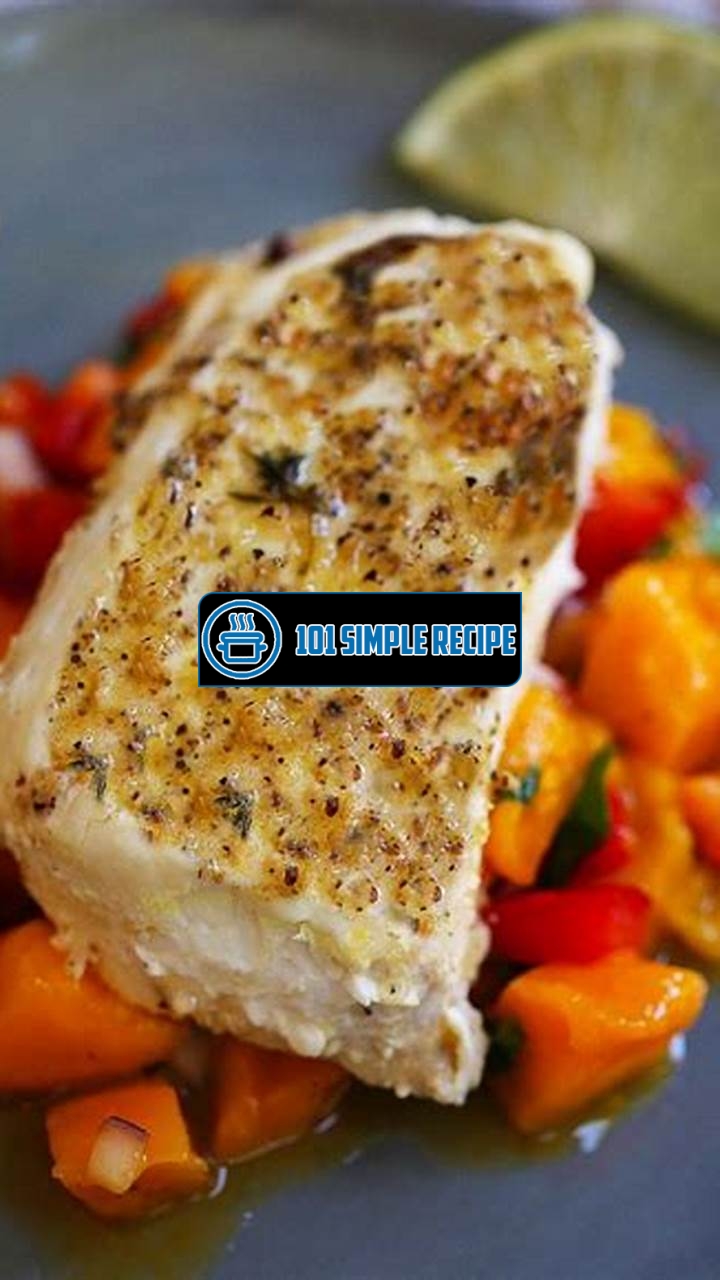Welcome to a flavorful and nutritious journey with the One Pan Mediterranean Baked Halibut Recipe with Vegetables! This delightful dish brings together the vibrant flavors of the Mediterranean in a simple and convenient way. Imagine succulent halibut fillets blanketed with a tantalizing medley of colorful vegetables , roasted to perfection in just one pan. This recipe is not only a feast for your taste buds but also a feast for the eyes. Whether you’re a seafood lover or just looking to infuse your meals with a burst of Mediterranean goodness, this recipe is sure to impress. Get ready to dive into a mouthwatering experience that will transport you to the shores of the Mediterranean Sea.

Understanding the Mediterranean Diet
The Mediterranean diet is a renowned and highly regarded eating pattern that emphasizes whole foods, fresh ingredients, and a balanced approach to nutrition. It is inspired by the traditional dietary patterns of countries surrounding the Mediterranean Sea, such as Greece, Italy, and Spain. This diet has gained immense popularity due to its numerous health benefits and ability to promote overall well-being.
Origins of the Mediterranean Diet
The origins of the Mediterranean diet can be traced back to the 1960s when researchers discovered that people living in Mediterranean countries had lower rates of heart disease and other chronic conditions. The Seven Countries Study conducted by Dr. Ancel Keys was one of the earliest studies that shed light on the health benefits of this eating pattern.
Since then, the Mediterranean diet has been extensively studied and recognized as one of the healthiest diets in the world. It not only focuses on the types of foods consumed but also encompasses a lifestyle approach that includes regular physical activity, sharing meals with family and friends, and savoring food.
Benefits of the Mediterranean Diet
The Mediterranean diet offers a wide range of benefits that contribute to overall health and well-being. Here are some key advantages:
- Promotes heart health: The Mediterranean diet is rich in heart-healthy foods such as fruits, vegetables, whole grains, legumes, and healthy fats like olive oil and nuts. These ingredients help reduce the risk of heart disease and improve cardiovascular health.
- Supports brain health: The diet’s emphasis on consuming omega-3 fatty acids found in fish, as well as antioxidants from fruits and vegetables, can help protect against cognitive decline and reduce the risk of neurodegenerative diseases like Alzheimer’s.
- Reduces the risk of chronic diseases: Following the Mediterranean diet has been associated with a lower incidence of chronic conditions such as type 2 diabetes, certain cancers, and obesity.
- Provides essential nutrients: The diet includes a variety of nutrient-dense foods, ensuring an adequate intake of vitamins, minerals, and antioxidants that are crucial for overall health and vitality.
- Promotes weight management: The Mediterranean diet encourages portion control, focuses on whole foods, and discourages processed foods and added sugars. These factors contribute to maintaining a healthy weight.
Key Components of the Mediterranean Diet
The Mediterranean diet primarily emphasizes the consumption of the following:
- Fruits and vegetables: These should make up a significant portion of your diet, providing essential nutrients, fiber, and antioxidants.
- Whole grains: Opt for whole grain bread, pasta, and cereals instead of refined grains to obtain a good source of fiber and nutrients.
- Legumes: Beans, lentils, and chickpeas are excellent sources of plant-based protein and fiber.
- Healthy fats: Olive oil is the primary source of healthy fats in the Mediterranean diet. Other sources include avocados and nuts.
- Lean proteins: Fish and seafood are the main sources of animal protein. Poultry, eggs, and dairy products are also consumed in moderation.
Additionally, the Mediterranean diet encourages moderate consumption of red wine (in moderation), staying hydrated with water, and limiting processed foods, sugary beverages, and added sugars.
Important Note: Before making any significant dietary changes, it is advisable to consult with a healthcare professional or registered dietitian to ensure that the Mediterranean diet is suitable for your individual needs and health goals.
By adopting the principles of the Mediterranean diet, you can optimize your nutrition, support your overall well-being, and enjoy a delicious and varied eating experience. Remember to focus on fresh, whole foods and savor the flavors of this beautiful and beneficial dietary pattern.
Introduction to Halibut
Halibut is a highly sought-after fish in Mediterranean cuisine due to its delicious taste and versatility in cooking. This large flatfish is known for its delicate and flaky white flesh, making it a popular choice for many seafood lovers. In addition to its wonderful taste, halibut also provides numerous health benefits, making it an excellent addition to any balanced diet. In this article, we will explore the characteristics and nutritional value of halibut, as well as the sustainability of halibut fishing.
What is Halibut?
Halibut is a species of flatfish that is native to the Mediterranean Sea. It belongs to the family of bothidae and is one of the largest flatfish species, with adults reaching lengths of up to 8 feet and weighing over 600 pounds. Halibut has a distinct diamond-shaped body that is flat and elongated, allowing it to blend seamlessly with the seabed. Its eyes are positioned on one side of its body, allowing it to lie flat on the ocean floor and easily camouflage itself.
Halibut is known for its mild and slightly sweet flavor, which pairs well with a variety of ingredients and seasonings. Its firm and flaky texture makes it suitable for grilling, baking, or frying. This versatility in cooking methods has made halibut a popular choice among chefs and home cooks alike.
Nutritional Profile of Halibut
Halibut is not only delicious but also packed with essential nutrients that are beneficial for overall health. It is a rich source of high-quality protein, which is necessary for muscle growth, repair, and maintenance. Additionally, halibut is low in calories and fat, making it a healthy option for those watching their weight.
- Omega-3 Fatty Acids: Halibut is an excellent source of omega-3 fatty acids, particularly eicosapentaenoic acid (EPA) and docosahexaenoic acid (DHA). These fatty acids have been linked to various health benefits, including reduced inflammation, improved heart health, and enhanced brain function.
- Vitamins and Minerals: Halibut is rich in several vitamins and minerals, including vitamin B12, vitamin D, selenium, and potassium. Vitamin B12 is essential for proper nerve function and the production of red blood cells, while vitamin D is important for bone health and immune system function. Selenium and potassium are vital for the proper functioning of various bodily processes.
- Astaxanthin: Halibut contains astaxanthin, a powerful antioxidant that gives it its pinkish color. Antioxidants help protect the body against cellular damage caused by harmful free radicals.
Incorporating halibut into your diet can help ensure that you are getting a wide range of essential nutrients to support your overall well-being.
Sustainability of Halibut Fishing
The sustainability of halibut fishing is an important consideration in order to preserve the health of the fish population and the marine ecosystem. Overfishing can have detrimental effects on halibut populations, disrupting the balance of marine life and leading to long-term negative consequences.
In recent years, efforts have been made to manage halibut fishing through regulations and monitoring. These measures aim to prevent overfishing and ensure the long-term sustainability of the species. The implementation of fishing quotas, size limits, and seasonal restrictions has helped maintain a healthy population of halibut in the Mediterranean Sea.
By choosing sustainably sourced halibut and supporting responsible fishing practices, consumers can contribute to the preservation of halibut populations and the overall health of the marine environment.
In conclusion, halibut is a delicious and nutritious fish that is highly valued in Mediterranean cuisine. It offers a range of health benefits and can be enjoyed in various cooking preparations. By understanding the characteristics of halibut, its nutritional profile, and the importance of sustainable fishing practices, you can make informed choices when incorporating halibut into your diet. So go ahead and explore the wonderful flavors and benefits of halibut with your favorite Mediterranean recipes!
Sourcing Fresh Ingredients
When it comes to preparing a delicious Mediterranean baked halibut dish, sourcing the best quality vegetables and herbs is essential. The freshness and flavor of these ingredients can greatly enhance the taste of your meal. In this section, we will explore how to choose and select the freshest vegetables and herbs for your recipe.
Seasonal vs. Year-Round Vegetables
When shopping for vegetables for your Mediterranean baked halibut, it’s important to consider whether they are seasonal or available year-round. Seasonal vegetables are typically harvested at their peak freshness and flavor, resulting in a more vibrant and tasty dish. Some popular seasonal options for this recipe include tomatoes, bell peppers, zucchini, and eggplant. These vegetables are not only bursting with flavor but also provide a colorful and visually appealing presentation to your dish. ️
On the other hand, year-round vegetables are available throughout the year but may not have the same level of freshness as seasonal ones. However, they can still be used in your Mediterranean baked halibut recipe, especially if the desired vegetables are not in season. Examples of year-round vegetables that work well in this dish include carrots, onions, and potatoes. While they may not be as flavorful as their seasonal counterparts, they can still contribute to the overall taste and texture of the dish.
Certified Organic Options
If you prefer to use organic ingredients in your cooking, opting for certified organic vegetables and herbs is an excellent choice. Organic vegetables are grown without the use of synthetic pesticides, fertilizers, and genetically modified organisms (GMOs). They are also typically grown in nutrient-rich soil, which can enhance their taste and nutritional value. By selecting certified organic options for your Mediterranean baked halibut recipe, you can be confident that you are using ingredients that are free from harmful chemicals and additives.
When shopping for organic vegetables, look for the “Certified Organic” label on the packaging. This ensures that the produce meets specific standards set by certifying agencies. Some common organic vegetables and herbs that go well with Mediterranean flavors include organic cherry tomatoes, organic basil, and organic oregano. Incorporating these organic options into your recipe adds an extra layer of freshness and healthfulness.
Flavorful Herbs and Spices
No Mediterranean baked halibut dish is complete without a selection of flavorful herbs and spices. These ingredients add depth and complexity to the overall taste of the recipe. Some popular herbs and spices to consider for your dish include fresh basil, oregano, thyme, and garlic. These aromatic herbs not only provide a burst of flavor but also contribute to the enticing aroma of your meal.
When using herbs and spices, it’s best to opt for fresh varieties whenever possible. Fresh herbs have a more vibrant taste compared to their dried counterparts and can elevate the flavors of your dish. If you can’t find fresh herbs, dried herbs can still be used, but in smaller quantities as their flavor is more concentrated. Experiment with different combinations of herbs and spices to find the perfect balance for your Mediterranean baked halibut.
Now that you know how to choose and select the best quality vegetables and herbs for your Mediterranean baked halibut recipe, you can create a flavorful and satisfying meal that will impress your family and friends. Enjoy the delicious flavors of the Mediterranean with this easy and wholesome dish!
If you’re in the mood for some delicious garlic bread, check out this garlic bread stick recipe. It’s quick and easy to make, and the result is a crispy, flavorful bread stick that’s perfect for dipping in soups or serving as a side dish. With just a few simple ingredients, you can have homemade garlic bread sticks that taste like they came from a restaurant!
Baking Techniques for Perfectly Cooked Halibut
Master the art of baking halibut to retain its moisture and maximize flavor in your one-pan Mediterranean dish.
Choosing the Right Baking Dish
When it comes to baking halibut, choosing the right baking dish is crucial for achieving the perfect results. Opt for a shallow baking dish that is large enough to accommodate the halibut fillets and vegetables without overcrowding. A dish that is approximately 9×13 inches in size should work well for this recipe.
Tip: To prevent the halibut from sticking to the baking dish, lightly grease the dish with olive oil or cooking spray before adding the ingredients.
Key Steps for Properly Preparing Halibut
Before you start baking the halibut, it’s essential to properly prepare the fillets to ensure they cook evenly and retain their moisture. Here are some key steps to follow:
- Thaw the halibut: If using frozen halibut fillets, make sure to thaw them completely before baking. You can thaw them in the refrigerator overnight or use the defrost setting on your microwave for quicker results.
- Season the fillets: Season the halibut fillets with salt, pepper, and any other desired herbs or spices. This step adds flavor to the fish and enhances the overall Mediterranean taste of the dish.
- Marinate for extra flavor: For an extra burst of flavor, consider marinating the halibut fillets in a mixture of olive oil, lemon juice, garlic, and herbs. Let the fillets marinate in the refrigerator for at least 30 minutes before baking.
- Pat dry: Before placing the halibut in the baking dish, make sure to pat the fillets dry using a paper towel. This step helps the fish to brown evenly and prevents excess moisture during baking.
Optimal Baking Time and Temperature
Knowing the optimal baking time and temperature is crucial for achieving perfectly cooked halibut fillets that are moist and flavorful. Follow these guidelines for best results:
| Halibut Thickness | Baking Temperature | Baking Time |
|---|---|---|
| About 1 inch | 400°F (200°C) | 10-12 minutes |
| About 1.5 inches | 400°F (200°C) | 12-15 minutes |
| About 2 inches | 400°F (200°C) | 15-18 minutes |
Note: The baking time may vary slightly depending on the thickness of the halibut fillets. It’s important to check the fish for doneness by inserting a fork into the thickest part of the fillet. The fish should be opaque and easily flake when done.
Tip: To infuse even more Mediterranean flavors into your dish, consider adding sliced tomatoes, olives, capers, or roasted red peppers to the baking dish alongside the halibut and vegetables.
By mastering these baking techniques, you’ll be able to create a mouthwatering one-pan Mediterranean baked halibut recipe with perfectly cooked fish and deliciously tender vegetables. Enjoy the flavors of the Mediterranean right in your own kitchen!
For a delicious and healthy Mediterranean dish, try this one pan Mediterranean baked halibut recipe with vegetables. It’s packed with flavor and nutrients, and it’s easy to make in just one pan. This recipe is a great option for a weeknight dinner or when you’re entertaining guests. The halibut is perfectly cooked and tender, and the vegetables are roasted to perfection. Give it a try and enjoy a taste of the Mediterranean!
Enhancing Flavor with Mediterranean Ingredients
When it comes to creating a delicious and flavorful meal, the Mediterranean region has long been known for its vibrant and diverse cuisine. Incorporating Mediterranean ingredients into your recipes can elevate the taste and aroma, taking your dishes to new heights. In this article, we’ll explore a variety of Mediterranean ingredients that can enhance the flavors of your one-pan Mediterranean baked halibut recipe with vegetables.
The Versatility of Olive Oil
No Mediterranean dish is complete without the rich and versatile taste of olive oil. This essential ingredient not only adds a smoothness to your recipes, but it also brings out the flavors of the other ingredients. Olive oil can be used as a marinade for the halibut, adding a subtle and delightful taste. Its high smoke point makes it ideal for roasting or baking the halibut in the oven, creating a crispy and flavorful exterior. Additionally, drizzling some olive oil over the vegetables before baking will infuse them with a delicious Mediterranean essence.
✨ Pro Tip: Use extra virgin olive oil for its robust flavor and health benefits.
The Tang of Citrus Fruits
Citrus fruits, such as lemons and oranges, are another crucial element in Mediterranean cuisine. Their tangy and refreshing flavors add brightness to any dish, including your baked halibut. Squeezing fresh lemon juice over the fish before baking adds a zesty twist that balances well with the richness of the olive oil. The natural acidity of citrus fruits also works wonders in tenderizing the halibut, resulting in a moist and succulent texture.
✨ Pro Tip: Grate some lemon zest for an extra burst of citrus flavor.
The Aromatic Essence of Garlic and Herbs
Garlic and various herbs are the fragrant pillars of Mediterranean cooking. They infuse dishes with enticing aromas and robust flavors. Incorporate minced garlic into your marinade or sprinkle it over the halibut and vegetables for an added layer of taste. Mediterranean herbs like oregano, thyme, and rosemary not only provide a delightful fragrance but also pair exceptionally well with the delicate flavor of halibut. Add a generous amount of these herbs to your dish to create a truly Mediterranean experience.
✨ Pro Tip: For a burst of freshness, garnish your baked halibut with chopped parsley or basil.
To summarize, the Mediterranean ingredients mentioned above are key players in enhancing the flavor of your one-pan Mediterranean baked halibut recipe with vegetables. The versatility of olive oil, the tang of citrus fruits, and the aromatic essence of garlic and herbs all work together to create a truly unforgettable dish. So next time you’re in the mood for a Mediterranean-inspired meal, don’t forget to incorporate these ingredients and take your baked halibut to the next level!
If you’re looking for a quick and easy dessert, try this cookie in a mug recipe. It’s perfect for when you’re craving something sweet but don’t want to spend a lot of time in the kitchen. All you need are a few basic ingredients and a microwave, and you’ll have a warm, gooey cookie in no time. It’s a fun and delicious treat that’s sure to satisfy your sweet tooth!
Frequently Asked Questions
Thank you for taking the time to read our article on the one pan Mediterranean baked halibut recipe with vegetables. We hope you found it informative and inspiring. If you have any further questions, please refer to the frequently asked questions below:
| No. | Questions | Answers |
|---|---|---|
| 1. | How long should I bake the halibut? | The baking time for the halibut will depend on the thickness of the fillets. As a general guideline, bake the halibut at 400°F (200°C) for about 10-12 minutes per inch of thickness. |
| 2. | Can I substitute halibut with another type of fish? | Yes, you can substitute halibut with other white fish such as cod, haddock, or sea bass. The cooking time may vary slightly depending on the fish you choose. |
| 3. | What vegetables can I use for this recipe? | You can use a variety of vegetables for this recipe, such as bell peppers, zucchini, cherry tomatoes, and red onion. Feel free to customize it with your favorite Mediterranean vegetables. |
| 4. | Can I use frozen fish for this recipe? | Yes, you can use frozen fish for this recipe. Just make sure to thaw it properly before baking. Pat the fish dry with paper towels to remove excess moisture. |
| 5. | What seasoning should I use for the halibut? | For a Mediterranean flavor, we recommend using a combination of olive oil, lemon juice, garlic, dried oregano, salt, and pepper to season the halibut. |
| 6. | Can I prepare the vegetables in advance? | Yes, you can chop and prepare the vegetables in advance and store them in an airtight container in the refrigerator. This will save you time when you’re ready to bake the halibut. |
Thank You for Reading!
We hope you enjoyed learning about the one pan Mediterranean baked halibut recipe with vegetables. It’s a delicious and healthy dish that brings the flavors of the Mediterranean to your table. Make sure to bookmark this page or subscribe to our newsletter for more delicious recipes and cooking tips. The next time you’re looking for a quick and flavorful meal, give this recipe a try! Happy cooking! ️
Jump to Recipe
One Pan Mediterranean Baked Halibut Recipe with Vegetables

Try this delicious one pan Mediterranean baked halibut recipe with vegetables. It’s a healthy and flavorful dish that is quick and easy to make. Perfect for a weeknight dinner or a special occasion.
- 4 halibut fillets
- 1 bell pepper (sliced)
- 1 zucchini (sliced)
- 1 cup cherry tomatoes
- 1 red onion (sliced)
- 3 tablespoons olive oil
- 1 lemon (juiced)
- 3 cloves garlic (minced)
- 1 teaspoon dried oregano
- Salt and pepper (to taste)
- Preheat the oven to 400°F (200°C).
- In a large baking dish, combine the sliced bell pepper, zucchini, cherry tomatoes, and red onion.
- Drizzle the vegetables with 2 tablespoons of olive oil and season with salt and pepper. Toss to coat evenly.
- Place the halibut fillets on top of the vegetables. Drizzle the fillets with the remaining olive oil and lemon juice. Sprinkle minced garlic and dried oregano over the fish. Season with salt and pepper.
- Bake in the preheated oven for 20 minutes or until the fish is cooked through and flakes easily with a fork.
- Serve the baked halibut and vegetables hot, garnished with fresh herbs if desired. Enjoy!






